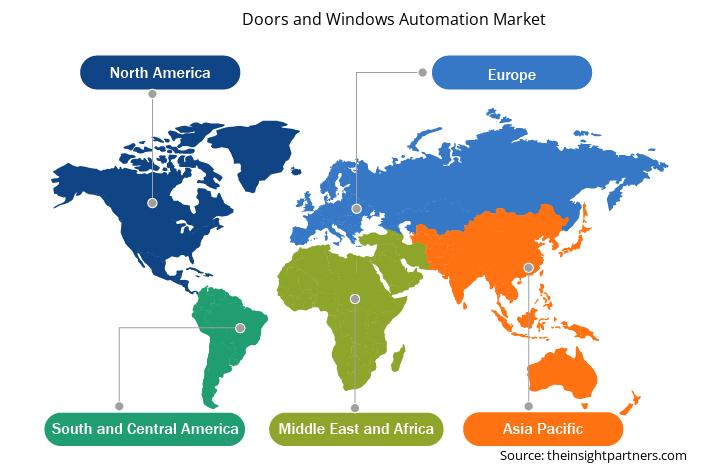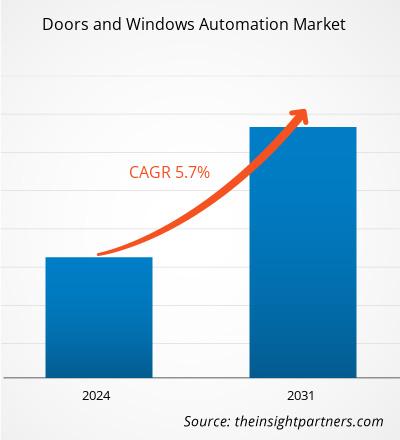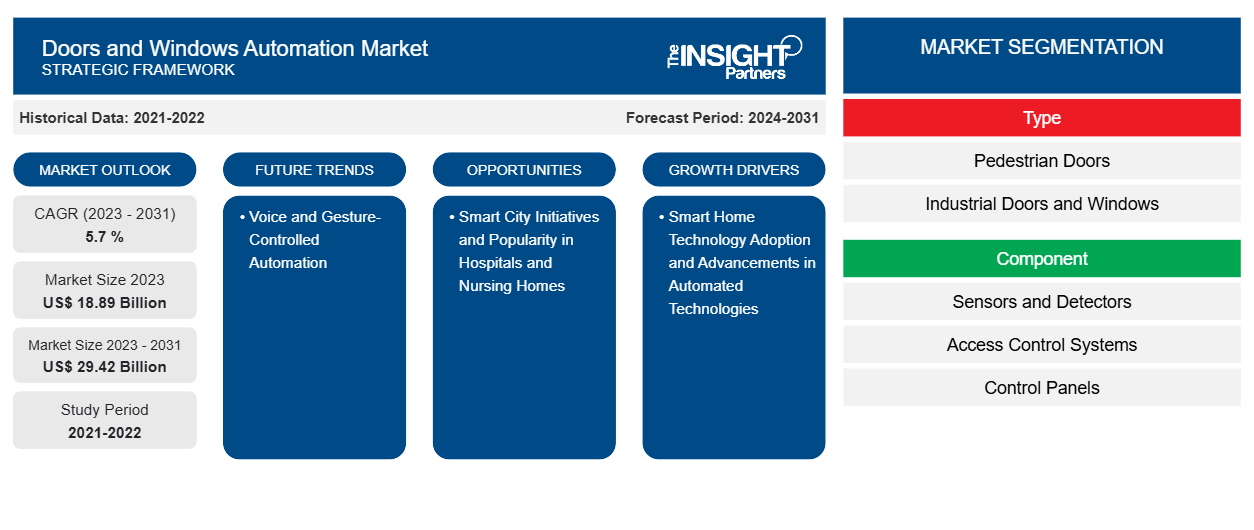Si prevede che il mercato dell'automazione di porte e finestre raggiungerà i 29,42 miliardi di dollari entro il 2031, rispetto ai 18,89 miliardi di dollari del 2023. Si stima che il mercato registrerà un CAGR del 5,7% nel periodo 2023-2031. È probabile che l'automazione controllata tramite voce e gesti porti nuove tendenze nel mercato dell'automazione di porte e finestre nei prossimi anni.
Analisi di mercato dell'automazione di porte e finestre
Fattori come l'adozione della tecnologia smart home e i progressi nelle tecnologie automatizzate stanno guidando il mercato dell'automazione di porte e finestre . Si prevede che il mercato crescerà nel periodo previsto a causa delle crescenti iniziative smart city e della crescente popolarità dei sistemi automatizzati negli ospedali e nelle case di cura. La domanda di soluzioni di automazione di porte e finestre è guidata da diversi fattori chiave, tra cui la crescente domanda di praticità, sicurezza ed efficienza energetica negli edifici residenziali e commerciali. I progressi tecnologici, come l'integrazione di sistemi smart home, controllo vocale e gestuale e sensori di movimento, stanno migliorando l'esperienza utente e consentendo un'automazione senza soluzione di continuità. Anche la crescente attenzione alla sostenibilità sta contribuendo alla crescita del mercato, poiché porte e finestre automatizzate ottimizzano la ventilazione e riducono il consumo energetico, con conseguenti risparmi sui costi. Inoltre, la crescente consapevolezza dell'igiene, in particolare in ambito sanitario e commerciale, ha accelerato l'adozione di sistemi di automazione touchless. Questi fattori, insieme all'urbanizzazione e alla crescente preferenza per case intelligenti e connesse, stanno alimentando l'espansione del mercato.
Panoramica del mercato dell'automazione di porte e finestre
L'automazione di porte e finestre si riferisce all'integrazione di tecnologie avanzate che consentono a porte e finestre di funzionare automaticamente, migliorando la praticità, la sicurezza, l'efficienza energetica e l'accessibilità. Questa automazione può essere ottenuta tramite sensori, motori e sistemi di controllo che consentono di aprire o chiudere porte e finestre in base a condizioni specifiche o comandi dell'utente. Le caratteristiche comuni includono il funzionamento touchless, attivato vocalmente o controllato tramite gesti, nonché l'integrazione intelligente con sistemi di automazione domestica per un controllo senza interruzioni tramite piattaforme come Amazon Alexa o Google Assistant. Questi sistemi automatizzati sono sempre più utilizzati sia negli edifici residenziali che commerciali, offrendo vantaggi come maggiore sicurezza, risparmio energetico tramite ventilazione ottimizzata e migliore igiene riducendo il contatto fisico con le superfici.
Personalizza questo report in base alle tue esigenze
Riceverai la personalizzazione gratuita di qualsiasi report, comprese parti di questo report, o analisi a livello nazionale, pacchetto dati Excel, oltre a usufruire di grandi offerte e sconti per start-up e università
-
Scopri le principali tendenze di mercato in questo rapporto.Questo campione GRATUITO includerà analisi di dati che spaziano dalle tendenze di mercato alle stime e alle previsioni.
Driver e opportunità del mercato dell'automazione di porte e finestre
Adozione della tecnologia per la casa intelligente
Le case intelligenti incorporano sistemi di automazione per porte e finestre, poiché i proprietari di casa cercano maggiore praticità, comfort, efficienza energetica e sicurezza. Come parte della tendenza più ampia delle tecnologie per la casa intelligente, insieme alla crescente disponibilità di dispositivi connessi, i consumatori stanno sempre più incorporando sistemi automatizzati nelle loro case per migliorare le esperienze di vita quotidiana e ridurre il consumo di energia. Aziende come Marvin, Somfy, WindowMaster e View Glass offrono soluzioni avanzate che collegano porte e finestre automatizzate alle case intelligenti. Ad esempio, a settembre 2023, Somfy, il principale produttore mondiale di motori per rivestimenti per finestre interne e protezione solare esterna, ha annunciato la sua integrazione e certificazione con Apple Home. Questa certificazione consente una compatibilità perfetta tra i motori Zigbee supportati da Somfy utilizzati nelle applicazioni per finestre interne e l'interruttore TaHoma con Apple Home. La tecnologia Zigbee 3.0, una soluzione IoT sicura e adottata a livello globale, facilita l'interoperabilità collegando i dispositivi per la casa intelligente a una rete unificata, consentendo ai prodotti di funzionare senza problemi. La nuova integrazione offre un modo semplice e sicuro per controllare le coperture per finestre motorizzate alimentate da Somfy utilizzando motori Zigbee tramite l'app Apple Home e Siri su dispositivi come iPhone, iPad, Apple Watch, HomePod e Mac. Pertanto, l'adozione della tecnologia smart home guida il mercato dell'automazione di porte e finestre.
Iniziative per le città intelligenti
Le città stanno diventando più avanzate e connesse tecnologicamente, il che porta a una crescente domanda di infrastrutture automatizzate in grado di ottimizzare le operazioni di costruzione, migliorare la sicurezza e migliorare l'efficienza energetica. Secondo il Programma delle Nazioni Unite per lo sviluppo, oltre il 60% della popolazione mondiale vive in città, di cui oltre il 70% è costituita da popolazione attiva; inoltre, l'80% del valore economico mondiale è generato nelle città. I governi di vari paesi stanno prendendo iniziative verso le città intelligenti incentrate sull'uso di Internet per condividere informazioni, migliorare l'efficienza operativa e fornire una migliore qualità del servizio ai cittadini che vivono in città intelligenti. Ad esempio, secondo il Ministero dello sviluppo urbano, ci sono un totale di 8.033 progetti (Smart Cities Mission) in 100 città dell'India, di cui 7.038 (88%) sono già completati e 995 (12%) sono progetti in corso. Allo stesso modo, nel 2023, il governo cinese ha annunciato il suo piano per costruire oltre 500 città intelligenti. A luglio 2023, il governo ha finanziato un progetto del valore di 200 milioni di dollari per sviluppare la fase 1 del progetto Guangzhou Smart City. Le iniziative per le città intelligenti prevedono l'adozione di varie tecnologie intelligenti, tra cui sistemi di automazione di porte e finestre, che rendono le operazioni più efficienti dal punto di vista energetico e sostenibili, oltre a ridurre al minimo le emissioni di carbonio. Inoltre, a Dubai, diversi edifici commerciali stanno incorporando porte e finestre automatizzate come parte della visione della città di diventare una delle principali città intelligenti al mondo, supportando l'integrazione di tecnologie intelligenti per sostenibilità e praticità. Inoltre, Dubai continua a guidare lo sviluppo delle città intelligenti, con progetti come Dubai Silicon Oasis che incorporano porte e finestre automatizzate per ottimizzare l'efficienza energetica negli edifici commerciali e residenziali. Questi sistemi sono progettati per adattarsi automaticamente in base alle condizioni meteorologiche, contribuendo al risparmio energetico e all'obiettivo della città di ridurre le emissioni di carbonio. Pertanto, si prevede che il crescente numero di iniziative nei progetti di città intelligenti creerà varie opportunità per la crescita del mercato durante il periodo di previsione.
Analisi della segmentazione del rapporto di mercato sull'automazione di porte e finestre
I segmenti chiave che hanno contribuito alla derivazione dell'analisi del mercato dell'automazione di porte e finestre sono tipologia, componente, sistema di controllo e settore verticale.
- In base al tipo, il mercato dell'automazione di porte e finestre è suddiviso in finestre, porte industriali e porte pedonali. Il segmento delle porte pedonali ha dominato il mercato nel 2023.
- In termini di componenti, il mercato dell'automazione di porte e finestre è suddiviso in sistemi di controllo accessi, pannelli di controllo, sensori e rilevatori, motori e attuatori e altri. Il segmento dei sensori e rilevatori ha rappresentato la quota maggiore del mercato nel 2023.
- In base al sistema di controllo, il mercato dell'automazione di porte e finestre è segmentato in completamente automatico, semi-automatico e servoassistito. Il segmento completamente automatico ha dominato il mercato nel 2023.
- In base al settore verticale, il mercato dell'automazione di porte e finestre è suddiviso in residenziale, commerciale e industriale. Il segmento commerciale ha detenuto la quota maggiore nel mercato dell'automazione di porte e finestre nel 2023.
Analisi della quota di mercato dell'automazione di porte e finestre per area geografica
Il mercato dell'automazione di porte e finestre è segmentato in cinque regioni principali: Nord America, Europa, Asia Pacifico (APAC), Medio Oriente e Africa (MEA) e Sud e Centro America. Il Nord America ha dominato il mercato nel 2023, seguito da Europa e APAC.
Il mercato dell'automazione di porte e finestre in Nord America è segmentato in Stati Uniti, Canada e Messico. I paesi più importanti in Nord America stanno assistendo a un aumento significativo di programmi per case intelligenti e città intelligenti. I governi di vari paesi della regione stanno incoraggiando l'adozione di città intelligenti, che dovrebbero dare impulso alle attività di costruzione residenziale e commerciale e alimentare la domanda di porte e finestre automatizzate. L'integrazione della tecnologia di automazione nei sistemi di porte e finestre aiuta a risparmiare energia, poiché aiuta a mantenere porte e finestre bloccate o sbloccate per un periodo ottimale.
Approfondimenti regionali sul mercato dell'automazione di porte e finestre
Le tendenze regionali e i fattori che influenzano il mercato Doors and Windows Automation durante il periodo di previsione sono stati ampiamente spiegati dagli analisti di Insight Partners. Questa sezione discute anche i segmenti e la geografia del mercato Doors and Windows Automation in Nord America, Europa, Asia Pacifico, Medio Oriente e Africa e Sud e Centro America.

- Ottieni i dati specifici regionali per il mercato dell'automazione di porte e finestre
Ambito del rapporto di mercato sull'automazione di porte e finestre
| Attributo del report | Dettagli |
|---|---|
| Dimensioni del mercato nel 2023 | 18,89 miliardi di dollari USA |
| Dimensioni del mercato entro il 2031 | 29,42 miliardi di dollari USA |
| CAGR globale (2023-2031) | 5,7% |
| Dati storici | 2021-2022 |
| Periodo di previsione | 2024-2031 |
| Segmenti coperti |
Per tipo
|
| Regioni e Paesi coperti |
America del Nord
|
| Leader di mercato e profili aziendali chiave |
|
Densità dei player del mercato dell'automazione di porte e finestre: comprendere il suo impatto sulle dinamiche aziendali
Il mercato Doors and Windows Automation Market sta crescendo rapidamente, spinto dalla crescente domanda degli utenti finali dovuta a fattori quali l'evoluzione delle preferenze dei consumatori, i progressi tecnologici e una maggiore consapevolezza dei vantaggi del prodotto. Con l'aumento della domanda, le aziende stanno ampliando le loro offerte, innovando per soddisfare le esigenze dei consumatori e capitalizzando sulle tendenze emergenti, il che alimenta ulteriormente la crescita del mercato.
La densità degli operatori di mercato si riferisce alla distribuzione di aziende o società che operano in un particolare mercato o settore. Indica quanti concorrenti (operatori di mercato) sono presenti in un dato spazio di mercato in relazione alle sue dimensioni o al valore di mercato totale.
Le principali aziende che operano nel mercato dell'automazione di porte e finestre sono:
- ABB Ltd
- Allegion Plc
- Assa Abloy AB
- Came SpA
- Honeywell International Inc
- Insteone
Disclaimer : le aziende elencate sopra non sono classificate secondo un ordine particolare.

- Ottieni una panoramica dei principali attori del mercato dell'automazione di porte e finestre
Notizie e sviluppi recenti del mercato dell'automazione di porte e finestre
Il mercato dell'automazione di porte e finestre viene valutato raccogliendo dati qualitativi e quantitativi dopo la ricerca primaria e secondaria, che include importanti pubblicazioni aziendali, dati associativi e database. Di seguito sono elencati alcuni degli sviluppi chiave nel mercato dell'automazione di porte e finestre:
- Allegion plc, tramite una delle sue sussidiarie, ha acquisito SOSS Door Hardware (SOSS). Produttore leader di cerniere e ferramenta per porte di alta qualità, SOSS vende principalmente le sue soluzioni nei mercati non residenziali del Nord America. Le soluzioni SOSS completano la ferramenta per porte Ives, Glynn-Johnson e Zero International dell'azienda, consentendo loro di specificare e fornire un portafoglio più ampio ai propri clienti e, in definitiva, di far crescere questa parte fondamentale del business.
(Fonte: Allegion plc, comunicato stampa, ottobre 2024)
- ABB ha presentato gli aggiornamenti del suo portafoglio di sistemi di ingresso ABB-Welcome alla fiera Light + Building di quest'anno a Francoforte. Le versioni di nuova generazione di ABB-Welcome e ABB-Welcome IP sono state lanciate con un design evoluto, un'architettura di sistema semplificata e una connettività migliorata. ABB-Welcome offre una soluzione versatile a 2 fili per la comunicazione delle porte con un'ampia gamma di design modulari. Comprende una gamma completa di stazioni esterne e interne. Le aree di ingresso delle case, inclusi cancelli e porte d'ingresso o d'ingresso, possono essere comodamente collegate ai telefoni cellulari per risposte più rapide alle chiamate effettuate alla porta; inoltre, l'accesso può essere concesso da remoto tramite un'app.
(Fonte: ABB, Comunicato stampa, marzo 2024)
Copertura e risultati del rapporto sul mercato dell'automazione di porte e finestre
"Dimensioni e previsioni del mercato dell'automazione di porte e finestre (2021-2031)" fornisce un'analisi dettagliata del mercato che copre le aree menzionate di seguito:
- Dimensioni e previsioni del mercato dell'automazione di porte e finestre a livello globale, regionale e nazionale per tutti i segmenti di mercato chiave coperti dall'ambito
- Tendenze del mercato dell'automazione di porte e finestre e dinamiche di mercato come driver, restrizioni e opportunità chiave
- Analisi PEST e SWOT dettagliate
- Analisi del mercato dell'automazione di porte e finestre che copre le principali tendenze del mercato, il quadro globale e regionale, i principali attori, le normative e i recenti sviluppi del mercato
- Analisi del panorama industriale e della concorrenza che copre la concentrazione del mercato, l'analisi della mappa di calore, i principali attori e gli sviluppi recenti nel mercato dell'automazione di porte e finestre
- Profili aziendali dettagliati
- Analisi storica (2 anni), anno base, previsione (7 anni) con CAGR
- Analisi PEST e SWOT
- Valore/volume delle dimensioni del mercato - Globale, Regionale, Nazionale
- Industria e panorama competitivo
- Set di dati Excel
Report recenti
Rapporti correlati
Testimonianze
Motivo dell'acquisto
- Processo decisionale informato
- Comprensione delle dinamiche di mercato
- Analisi competitiva
- Analisi dei clienti
- Previsioni di mercato
- Mitigazione del rischio
- Pianificazione strategica
- Giustificazione degli investimenti
- Identificazione dei mercati emergenti
- Miglioramento delle strategie di marketing
- Aumento dell'efficienza operativa
- Allineamento alle tendenze normative























 Ottieni un campione gratuito per - Mercato dell'automazione di porte e finestre
Ottieni un campione gratuito per - Mercato dell'automazione di porte e finestre